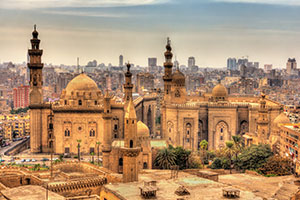|
Valley of the Queens
|
|
Valley of the Kings
Valley of the Kings
The Valley of the Kings in Upper Egypt contains many of the tombs of pharaohs from the New Kingdom, including Tutankhamun and Ramesses the Great.
The Valley of the Kings actually has two components - the East Valley and the West Valley. It is the East Valley which most tourists visit and in which most of the tombs of the New Kingdom Pharaohs can be found. (The West Valley has only one remote tomb open to the public, that of Ay who was Tutankhamun's successor.)
|
|
Esna (Isna)
Esna (Isna)
Isna is located about 33 miles south of Luxor. The town's Greek name was Latopolis and here fish (lates) where thought to embody the goddess Neith, who was sacred to the area. Isna was increasingly important during the 18th dynasty due to Egypt's developing relationship with the Sudan. There was a route established between Isna and Derr. Later, the city slowly declined until it received renewed interest during the 26th Dynasty. Later, under the Greeks and Romans, it became the capital of the Third Nome of Upper Egypt.
|
|
Kom Ombo
Kom Ombo
In Kom Ombo tourists can visit the roofless Temple of Kom Ombo which was built for the falcon and crocodile gods. The Temple of Sobek is another attraction in Kom Ombo where a mummified crocodile can be seen!
|
|
|
Agilkia Island
|
|
|
Philae
|
|
|
Nile River Cruising
|
|
Cairo
Cairo
Cairo and the ancient monuments of the Egyptian empire have fascinated visitors throughout the centuries. The mystifying Sphinx and the pyramids of Giza, over four thousand years old, stand majestically on the outskirts of the city at the edge of the desert. Cairo's Museum of Antiquities holds one of the finest collections of artifacts in the world, including the astounding treasures of King Tutankhamen's tomb.
|
Destination Guide
|
Luxor
Luxor
Aside from visiting the pyramids near Cairo, Luxor and Al Karnak are places not to be missed when in search of ancient Egyptian monuments and artifacts. Luxor is on the southern part of ancient Thebes, Al Karnak on the north. Between the two, visitors can lose themselves for days in the hundreds of temples, chapels, tombs and gardens in the area. Too extensive to list all of them, a few of the tombs not to be missed are the tombs of Nefertari, Amenhotep II & III, several Ramesses and Tutankhamen.
|
Destination Guide
|
Aswan
Aswan
Aswan is Egypt's sunniest southern city and has a distinctively African atmosphere. The pace of life here in the most beautiful setting on the Nile is slow and relaxing. It is a favorite winter resort spot for Europeans, Middle Easterns and Africans alike - it's a perfect place to get away from it all. Strolling up and down the Corniche, one can watch sailboats glide by. Savor the flavor of locally caught fish while listening to Nubian music or wander in the bazaar and get lost in the sights and sounds of this mystical place. Visit the Aga Khan Mausoleum, the Monastery at Qubbat al-Hawa, the Unfinished Obelisk, The Tombs of the Nobles, Qubbat al-Hawa, the Monastery at Aswan , or the St. Simeon monastery (Anba Hatre), uninhabited and just outside of Aswan.
|
Destination Guide
|
Istanbul
Istanbul
This centuries old capital guards the slender waterway between the Mediterranean and the Black Sea, and is the doorway between the East and West. Visitors can explore remnants of Byzantine Constantinople in the Sultanahmet district, where you will have the chance to see ancient splendors, such as the Haghia Sophia, the Blue Mosque and Topkapi Palace. At night the city boast a lively nightclub scene and excellent Turkish dining options that may include cultural entertainment and dancing. Istanbul also features splendid shopping malls, boutiques, and hand crafted items can be found all over the city.
|
Destination Guide
|
Athens
Athens
Even though you've probably come here to see the "glory that was Greece," perhaps best symbolized by the Parthenon and the superb statues and vases in the National Archaeological Museum, allow some time to make haste slowly in Athens. Your best moments may come sitting at a small cafe, sipping a tiny cup of the sweet sludge that the Greeks call coffee, or getting hopelessly lost in the Plaka -- only to find yourself in the shady courtyard of an old church, or suddenly face to face with an ancient monument you never knew existed. With only a little advance planning, you can find a good hotel here, eat well in convivial restaurants, enjoy local customs such as the refreshing afternoon siesta and the leisurely evening volta (promenade or stroll) -- and leave Athens planning to return, as the Greeks say, tou chronou (next year).
|
Destination Guide
|






